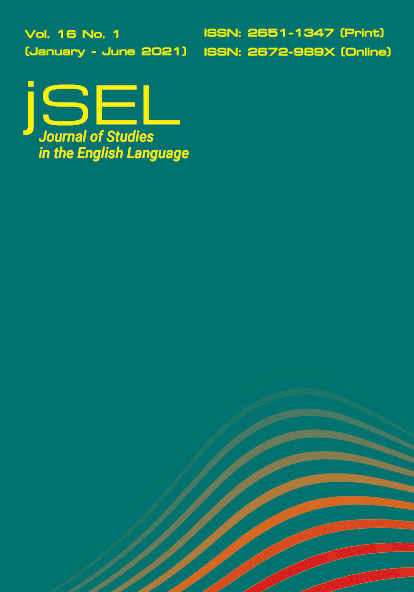Thai English, Acceptable or Just Likable? A Study of Foreign Tourists’ Perception of Thai English
Main Article Content
Abstract
Although Standard English is generally adopted as the ultimate goal in Thai EFL classrooms, it is undeniable that Thai English, a non-standard form of English in Thailand, is still commonly used in many contexts in the country, including tourism. Accordingly, Thai English has been questioned about how it reflects the speakers’ hierarchy status and individual personal attributes. Therefore, this present study aimed to investigate foreign tourists’ perceptions towards Thai English in the two aspects of an individual speaker’s social status personality traits. Mixed-method research was employed to survey and interview one hundred international tourists in Bangkok from four regions: East Asia, Southeast Asia, Europe, and North America. The results showed that the overall personality traits received more positive feedback than social status. Interestingly, the frequency of linguistic variation occurrence in speech samples played a tremendous role in the participants’ perception towards the social status of the speaker including education, proficiency, and acceptability as it aroused their negative feedback. In conclusion, this study provides the missing puzzle pieces in the form of the viewpoints of non-Thais to Thai English raising the awareness of the Thai English features that Thais should be concerned with when using English to communicate internationally for their specific needs and purposes.
Article Details
References
Assael, H. (1995). Consumer behaviour & marketing action (5th ed.). PWS-Kent Publishing Company.
Baker, W. (2008) Intercultural awareness and intercultural communication through English: An investigation of Thai English language users in higher education. [Unpublished doctoral dissertation]. University of Southampton.
Bennui, P. (2017). Speaking Tinglish for professional communication: A reflection of Thai English used by tour guides along the Andaman sea. Silpakorn University Journal of Social Sciences, Humanities, and Arts, 17(3), 233-266.
Buripakdi, A. (2012). On professional writing: Thai writer’s views on their English. International Journal of Applied Linguistics, 22(2), 245-264.
Cavallaro, F., & Ng, B. C. (2009). Between status and solidarity in Singapore. World Englishes, 28(2), 143-159.
Chamcharatsri, P. B. (2013). Perception of Thai English. Journal of English as an International Language, 8(1), 21-36.
Choedchoo, K. (2015). English as a lingua franca elicited in Asean accents. International Journal of Management and Applied Science, 1(9), 119-124.
Crystal, D. (2003). English as a global language (2nd ed.). Cambridge University Press.
Derwing T. M., Rossiter, M. J., & Munro, M. J. (2002) Teaching native speakers to listen to foreign-accented speech. Journal of Multilingual and Multicultural Development, 23(4), 245-259. https://doi.org/10.1080/01434630208666468
Jaroensak, T., & Saraceni, M. (2019). ELF in Thailand: Variants and coinage in spoken ELF in tourism encounters. REFLections, 26(1), 101-118.
Jenkins, J. (2003). World Englishes: A resource book for students. Routledge.
Jindapitak, N., & Teo, A. (2012). Thai tertiary English majors’ attitudes towards and awareness of world Englishes. Journal of English Studies, 7, 74-116.
Jorgensen, G. (2017). World's greatest city: 50 reasons why Bangkok is No. 1. Retrieved September 10, 2019, from https://edition.cnn.com/travel/article/bangkok-worlds-greatest-city/index.html
Kachru, B. B. (1985). Standards, codification and sociolinguistic realism: The English language in the outer circle. In R. Quirk & H. G. Widdowson (Eds.), English in the world: Teaching and learning of language and literature (pp. 11-30). Cambridge University Press.
Laurence, E. (2013). English with an accent: Language, ideology, and discrimination in the United States [Review of the book English with an accent: Language, ideology, and discrimination in the United States, by R. Lippi-Green]. Colombian Applied Linguistics Journal, 15(2), 310-311.
Lindsay, P. H., & Norman, D. A. (1977). Human information processing: An introduction to Psychology (2nd ed.). Academic Press.
Lindemann, S. (2005). Who speaks "broken English"? US undergraduates' perceptions of non-native English. International Journal of Applied Linguistics, 15(2), 187-212. https://doi.org/10.1111/j.1473-4192.2005.00087.x
Milroy, J., & Milroy L. (1991). Authority in language: Investigating language prescription and standardization. Routledge.
Phuengpitipornchai, K., & Teo, A. (2020.) You understand I na ka?: A study of comprehensibility of Thai English to foreign tourists. [Manuscript submitted for publication].
Pickens, J. (2005). Attitudes and perception. In N. Borkowski (Ed.), Organizational behaviour in health care (pp. 43-76). Jones and Bartlett Publishers.
Prakaiborisuth, P., & Trakulkasemsuk, W. (2015). Attitudes of Thai university students towards ASEAN Englishes. Proceedings of the 7th International Conference on Humanities and Social Sciences “ASEAN 2015: Challenges and Opportunities” (pp. 62-74). http://iw.libarts.psu.ac.th/conference/index.php/26-7th-international-conference-on-humanities-and-social-sciences
Rogers, U. (2013). Thai English as a variety. [Unpublished doctoral dissertation]. Arizona State University.
Saengboon, S. (2015). An exploratory study of Thai university students’ understanding of World Englishes. English Language Teaching, 8(11), 131-154.
Sowden, C. (2012). ELF on a mushroom: The overnight growth in English as a lingua franca. ELT Journal, 66(1), 89-96.
Ministry of Tourism and Sports (2018, October 8). Tourism receipts from international tourist arrivals in Jan-Dec 2017. Retrieved October 1, 2019, from https://www.mots.go.th/mots_en/News-link.php?nid=3626
Watkhaolarm, P. (2005). Think in Thai, write in English: Thainess in Thai English literatures. World Englishes, 24(2), 145-158.
Weerachairattana, R., Duan, J., & Buripakdi, A. (2019). World Englishes in Expanding Circle: Views from university students in Thailand and China. Journal of Studies in the English Language, 14(1), 125-181.
Wilang, J. D., & Teo, A. (2012). Measuring the comprehensibility of Englishes within ASEAN among Aseans. International Journal of English and Literature, 2(3), 22-42.
Ying Ying, T., & Castelli, C. (2013). Intelligibility and attitudes: How American English and Singapore English are perceived around the world. English World-Wide, 34(2), 177-201. https://doi.org/10.1075/eww.34.2.03tan


